Top ten tree and shrub symbols: Cypress, agave, weeping willows and gums
Bill Dennison ·This is the fourth blog post in a series which celebrates the Integration and Application Network (IAN) symbol library by highlighting some of the most interesting symbols. The previous blogs were on marine flora and fauna, and birds and this blog is focused on trees and shrubs in the IAN symbol library.
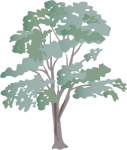 1) The Gum Tree (Eucalyptus spp.) symbol is one of my favorites, with its distinctive shiny leaves, open canopy and mottled bark. Fire resistant Eucalyptus trees are the dominant tree of Australia, with over 700 species. They are fast growing trees and contain oil which is released from their leaves, which can produce a haze like in the Australian Blue Mountains west of Sydney. Someone should produce a ‘scratch and sniff’ version of the symbol, as Eucalyptus trees are very aromatic. The fruits of Eucalyptus trees are ‘gum nuts’, featured in May Gibbs’ Australian children’s classic “The Complete Adventures of Snugglepot and Cuddlepie”. There is a wonderful novel “Eucalyptus” by Murray Bail which won the Miles Franklin Award in 1999 and weaves the classification of Eucalyptus trees into the story of a young Australian woman. This symbol was created by Lana Heydon.
1) The Gum Tree (Eucalyptus spp.) symbol is one of my favorites, with its distinctive shiny leaves, open canopy and mottled bark. Fire resistant Eucalyptus trees are the dominant tree of Australia, with over 700 species. They are fast growing trees and contain oil which is released from their leaves, which can produce a haze like in the Australian Blue Mountains west of Sydney. Someone should produce a ‘scratch and sniff’ version of the symbol, as Eucalyptus trees are very aromatic. The fruits of Eucalyptus trees are ‘gum nuts’, featured in May Gibbs’ Australian children’s classic “The Complete Adventures of Snugglepot and Cuddlepie”. There is a wonderful novel “Eucalyptus” by Murray Bail which won the Miles Franklin Award in 1999 and weaves the classification of Eucalyptus trees into the story of a young Australian woman. This symbol was created by Lana Heydon.
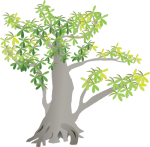 2) The Pisonia (Pisonia spp.) tree is a really bizarre tree that grows on the coral cays of the Great Barrier Reef. I spent a lot of time on Heron Island which supports a large Pisonia forest, which we often called “The Enchanted Forest”. These trees have huge trunks and limbs which tens of thousands of Black Noddy Terns (Anous minutus) nest in. The dirt around their roots was excavated by hundreds of nesting Wedgetailed Shearwaters (Puffinus tenuirostris; muttonbirds) as well. In spite of their girth and size, these trees would often fall down or shed limbs, leaving hundreds of homeless Noddy Terns circling endlessly. This symbol was created by Catherine Collier.
2) The Pisonia (Pisonia spp.) tree is a really bizarre tree that grows on the coral cays of the Great Barrier Reef. I spent a lot of time on Heron Island which supports a large Pisonia forest, which we often called “The Enchanted Forest”. These trees have huge trunks and limbs which tens of thousands of Black Noddy Terns (Anous minutus) nest in. The dirt around their roots was excavated by hundreds of nesting Wedgetailed Shearwaters (Puffinus tenuirostris; muttonbirds) as well. In spite of their girth and size, these trees would often fall down or shed limbs, leaving hundreds of homeless Noddy Terns circling endlessly. This symbol was created by Catherine Collier.
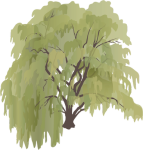 3) The Weeping Willow (Salix x sepulcralis) has a distinctive drooping tree canopy and is common in North America. The genus and species name of the weeping willow is complicated, as it is actually a hybrid of two different willow species; Salix babylonica from China and Salix alba from Europe. Willows grow along stream banks and in waterlogged soils. There was a large weeping willow near our vacation cottage in Michigan with branches that we could canoe underneath. The drooping branches and long, shimmering willow leaves created a light green curtain. The bark of the willow tree has salicylic acid, used to make aspirin, so willows are useful trees as well as being pretty trees. This symbol was created by Kim Kreear and Lucy Van Essen-Fishman.
3) The Weeping Willow (Salix x sepulcralis) has a distinctive drooping tree canopy and is common in North America. The genus and species name of the weeping willow is complicated, as it is actually a hybrid of two different willow species; Salix babylonica from China and Salix alba from Europe. Willows grow along stream banks and in waterlogged soils. There was a large weeping willow near our vacation cottage in Michigan with branches that we could canoe underneath. The drooping branches and long, shimmering willow leaves created a light green curtain. The bark of the willow tree has salicylic acid, used to make aspirin, so willows are useful trees as well as being pretty trees. This symbol was created by Kim Kreear and Lucy Van Essen-Fishman.
 4) The Bald Cypress (Taxodium distichum) with its buttress roots and knobbly 'knees' is an interesting tree that can grow in permanently waterlogged soils. The Cypress tree 'knees' contain specialized cells that form pneumatophores which are thought to help ventilate below ground roots. The problem with growing in permanently waterlogged soils is that reducing conditions occur and oxygen diffusion in water is much much slower than in air. Oxygen is necessary to avoid anaerobic respiration which produces ethanol which can become toxic. Bald Cypress trees are mostly tropical and subtropical, but they extend up as far as the Pokomoke River in the Chesapeake Bay watershed. Tracey Saxby created this symbol which includes the distinctive knees.
4) The Bald Cypress (Taxodium distichum) with its buttress roots and knobbly 'knees' is an interesting tree that can grow in permanently waterlogged soils. The Cypress tree 'knees' contain specialized cells that form pneumatophores which are thought to help ventilate below ground roots. The problem with growing in permanently waterlogged soils is that reducing conditions occur and oxygen diffusion in water is much much slower than in air. Oxygen is necessary to avoid anaerobic respiration which produces ethanol which can become toxic. Bald Cypress trees are mostly tropical and subtropical, but they extend up as far as the Pokomoke River in the Chesapeake Bay watershed. Tracey Saxby created this symbol which includes the distinctive knees.
 5) The Agave plant (Agave spp.), sometimes called the Century Plant, is a beautiful desert succulent plant. It is called a Century Plant because the plants were thought to only flower after a hundred years. The flowering stalk can shoot up to several meters. The Agave is related to the Yucca plants and to Aloe plants. While all of these plants are succulent, none are actually cacti. The Agave can be eaten, and some Native Americans relied on them as a major food source, as well as used them as a fiber source. This symbol was drawn by Tracey Saxby.
5) The Agave plant (Agave spp.), sometimes called the Century Plant, is a beautiful desert succulent plant. It is called a Century Plant because the plants were thought to only flower after a hundred years. The flowering stalk can shoot up to several meters. The Agave is related to the Yucca plants and to Aloe plants. While all of these plants are succulent, none are actually cacti. The Agave can be eaten, and some Native Americans relied on them as a major food source, as well as used them as a fiber source. This symbol was drawn by Tracey Saxby.
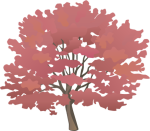 6) The Red Maple (Acer rubrum) symbol comes in two versions, the green summer foliage and the red autumn foliage. I prefer the autumn foliage, as do Canadians, since the red maple leaf is on their national flag. These large deciduous trees produce sugars which they store in their roots and trunk and then transport to their leaves in the spring. Native Americans learned to tap into the xylem in the spring and intercept this sap which can be concentrated into maple syrup. I also like the individual leaf that accompanies the tree symbol, with its intricate venation. Quite appropriately, this symbol was drawn by our Canadian Science Communicator Tracey Saxby.
6) The Red Maple (Acer rubrum) symbol comes in two versions, the green summer foliage and the red autumn foliage. I prefer the autumn foliage, as do Canadians, since the red maple leaf is on their national flag. These large deciduous trees produce sugars which they store in their roots and trunk and then transport to their leaves in the spring. Native Americans learned to tap into the xylem in the spring and intercept this sap which can be concentrated into maple syrup. I also like the individual leaf that accompanies the tree symbol, with its intricate venation. Quite appropriately, this symbol was drawn by our Canadian Science Communicator Tracey Saxby.
 7) The White Oak (Quercus alba) is one of the sturdy hardwood trees that comprise the oak-hickory climax forests of the eastern United States. This species forms a dense leaf canopy which makes for a nice shady spot in the summertime. Oaks produce acorns which means that there are usually lots of squirrels scurrying around their branches. The white oak leaves have distinctive rounded tips and turn vivid colors in the autumn.
7) The White Oak (Quercus alba) is one of the sturdy hardwood trees that comprise the oak-hickory climax forests of the eastern United States. This species forms a dense leaf canopy which makes for a nice shady spot in the summertime. Oaks produce acorns which means that there are usually lots of squirrels scurrying around their branches. The white oak leaves have distinctive rounded tips and turn vivid colors in the autumn.
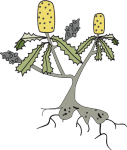 8) The Banksia (Banksia spp.) tree is one of the most iconic Australian plants for several reasons. Banksia plants are endemic to Australia as part of the flora that evolved on the Gondwana supercontinent. They were named by Linnaeus in recognition of the botanist Sir Joseph Banks who collected Banksia in the voyage of the Endeavour by Captain James Cook in 1770. They produce nectar which feeds endemic Australian fauna like honeyeaters and possums. Banksia are members of the Proteaceae family, named after Proteus, the Greek sea God who was flexible and changeable. Banksia trees come in all shapes and forms, are fire resistant and the large seed pods are called Banksia men by May Gibbs. This symbol, drawn by Lana Heydon, highlights the Proteid roots (or cluster roots) which are adaptations for extremely low nutrient soils, typical in Australia.
8) The Banksia (Banksia spp.) tree is one of the most iconic Australian plants for several reasons. Banksia plants are endemic to Australia as part of the flora that evolved on the Gondwana supercontinent. They were named by Linnaeus in recognition of the botanist Sir Joseph Banks who collected Banksia in the voyage of the Endeavour by Captain James Cook in 1770. They produce nectar which feeds endemic Australian fauna like honeyeaters and possums. Banksia are members of the Proteaceae family, named after Proteus, the Greek sea God who was flexible and changeable. Banksia trees come in all shapes and forms, are fire resistant and the large seed pods are called Banksia men by May Gibbs. This symbol, drawn by Lana Heydon, highlights the Proteid roots (or cluster roots) which are adaptations for extremely low nutrient soils, typical in Australia.
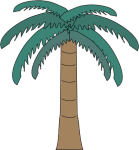 9) The symbol of a palm tree (Arecaceae) is one of the most used symbols used to depict a tropical coastal ecosystem like a beach, island or coral cay. Its outline is easily recognizable from a distance or in a conceptual diagram. Palm trees are iconic tropical and subtropical trees that produce important foods like coconuts, dates or figs. Palms are used in various cultures as a source of fiber, firewood, food, water, and even antiseptics. This symbol was one of the first round to be included in the IAN symbol library and was created by Diana Kleine.
9) The symbol of a palm tree (Arecaceae) is one of the most used symbols used to depict a tropical coastal ecosystem like a beach, island or coral cay. Its outline is easily recognizable from a distance or in a conceptual diagram. Palm trees are iconic tropical and subtropical trees that produce important foods like coconuts, dates or figs. Palms are used in various cultures as a source of fiber, firewood, food, water, and even antiseptics. This symbol was one of the first round to be included in the IAN symbol library and was created by Diana Kleine.
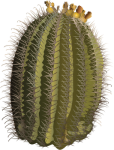 10) The Fishhook Barrel Cactus (Ferocactus wislizeni) is a classic cacti of the American Southwest. This symbol has enough detail to identify the curved spines (fishhooks) and barrel shape that give this cactus its name. Another subtle detail in this symbol is the shading and slight lean that the cactus has towards the sun. This is another characteristic of this species, it leans toward the south (prompting the nickname, 'Compass Barrel Cactus'), which may be a response to the intense afternoon sun. These small details illustrate the ability of IAN symbols to capture the salient features of a species. This beautiful symbol was created by Kim Kraeer and Lucy Van Essen-Fishman.
10) The Fishhook Barrel Cactus (Ferocactus wislizeni) is a classic cacti of the American Southwest. This symbol has enough detail to identify the curved spines (fishhooks) and barrel shape that give this cactus its name. Another subtle detail in this symbol is the shading and slight lean that the cactus has towards the sun. This is another characteristic of this species, it leans toward the south (prompting the nickname, 'Compass Barrel Cactus'), which may be a response to the intense afternoon sun. These small details illustrate the ability of IAN symbols to capture the salient features of a species. This beautiful symbol was created by Kim Kraeer and Lucy Van Essen-Fishman.
About the author
Bill Dennison

Dr. Bill Dennison is a Professor of Marine Science and Vice President for Science Application at the University of Maryland Center for Environmental Science.
Next Post > Top ten bird symbols: Kookaburras, flamingos, geese and tropicbirds
Comments
-
Miaohua 13 years ago
This is really very educational knowledges about tree. I saw Salix babylonica and red maple in Chinese university campus, and the gum tree and Bald Cypress in Princess Anne. I saw the palm tree only in TV, most of the trees are near the coastal areas.

